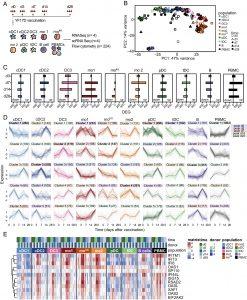A new study provides important insights into how the highly effective YF17D yellow fever vaccine activates the human immune system—offering valuable clues for designing new, fast-acting vaccines (Figure 1). The findings highlight how dendritic cells (DCs) and monocytes respond to vaccination and reveal a potential biomarker for protective immunity.

Figure 1: YF17D vaccination induces common and distinct time-dependent transcriptome changes in blood APC subpopulations. (A) Experimental design of the study. (B) PCA of VST-transformed bulk RNA-seq data after prefiltering. Sorted populations are indicated by colors and the symbols indicate the time after vaccination. (C) DESeq2 was used to find the significantly up- and downregulated genes (adjusted P < 0.05, Bonferroni corrected) of each population and each time point after YF17D vaccination compared to day 0. The number of up- and downregulated DEGs are shown and the colors indicate the populations. (D) Expressed genes (log counts per million ≥ 0.5) with significant changes in expression between time points (ANOVA, P < 0.05) were clustered according to their similar dynamic of expression over time for each population. Colored lines connect the average expression of each gene at the indicated time points (z-score scaled per row). Line colors refer to the cell populations. Clusters are numbered in random order. Clusters in bold have the highest gene number compared to other clusters within the population. Numbers in brackets indicate the number of genes in each cluster. Cluster headings are highlighted in colors indicating different dynamics with peak of gene expression on day 0 (blue), on day 3 (pink), on day 7 (red), on day 14 (orange), or on day 28 (green). (E) Heatmap showing hierarchically clustered DEG upregulated on day 7 vs. day 0 common to all APC subsets (cDC1, cDC2, DC3, mo1, moint, mo2, tDC, pDC, B, and PBMCs). Gene expression is indicated by the color (red: high expression, blue: low expression) for each donor and all DC and monocyte subpopulations, B cells, and PBMCs. Time points, vaccinees, and subpopulations indicated by colors above the heatmap. Four samples were excluded due to insufficient quality.
Key Findings
- In a cohort of 200+ healthy adults, researchers tracked dendritic cells and monocytes before and after yellow fever vaccination.
- Within one week of vaccination, these immune cells showed activation driven by interferons—critical antiviral signalling molecules.
- SIGLEC-1, a cell surface molecule, became significantly elevated on certain DC and monocyte subsets post-vaccination.
- Higher SIGLEC-1 levels correlated with faster and stronger antibody production, suggesting it plays a role in rapid immune protection.
The YF17D vaccine is considered one of the most effective vaccines ever developed—a single dose can confer lifelong protection. Understanding why it’s so potent helps guide:
- Design of vaccines for emerging viruses
- Development of fast-acting immunizations for epidemic response
- Identification of early biomarkers of vaccine efficacy
Journal article: Winheim, E., et al. 2025. Interferon-induced activation of dendritic cells and monocytes by yellow fever vaccination correlates with early antibody responses. Proceedings of the National Academy of Sciences.
Summary by Stefan Botha










